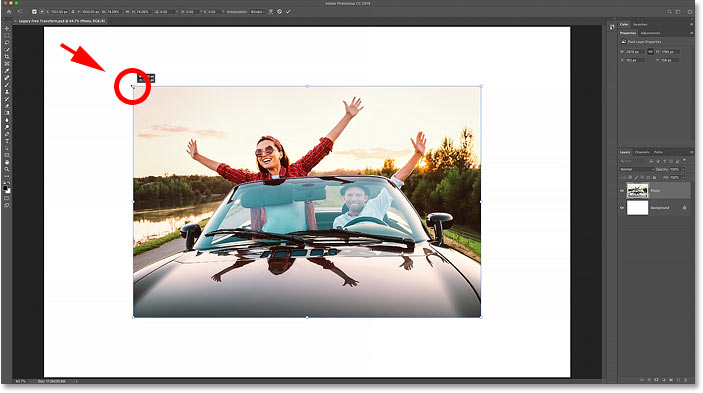Reviving Precision: A Comprehensive Guide on Restoring the Legacy Free Transform Command in Photoshop CC 2019

Introduction:
In the dynamic world of digital imaging, Adobe Photoshop stands as a beacon of creative prowess, constantly evolving to meet the needs of its diverse user base. However, with innovation comes change, and sometimes, beloved features undergo transformations. The introduction of the new Free Transform command in Photoshop CC 2019 left some users longing for the familiarity of its legacy counterpart. In this comprehensive guide, we will explore the intricacies of restoring the Legacy Free Transform command in Photoshop CC 2019. From understanding the changes to implementing solutions, this tutorial aims to empower users to reclaim the precision and workflow efficiency they cherished in the legacy version.
Section 1: Evolution of the Free Transform Command
- Introduction to Photoshop CC 2019:
- Provide an overview of the features and enhancements introduced in Photoshop CC 2019. Highlight the positive changes that accompanied the Free Transform command update.
- User Feedback and Concerns:
- Discuss the user feedback and concerns that emerged following the introduction of the new Free Transform command. Address common sentiments and frustrations shared by the Photoshop community.
Section 2: Understanding the Changes in Free Transform
- New Free Transform vs. Legacy Free Transform:
- Compare the functionalities of the new Free Transform command with its legacy counterpart. Explore the differences in user interface, control options, and overall user experience.
- Benefits of the New Free Transform:
- Acknowledge the advantages and improvements brought about by the updated Free Transform command. Discuss scenarios where the new features enhance efficiency and creative flexibility.
Section 3: The Quest for Legacy Precision
- Identifying User Needs:
- Examine the specific user needs and scenarios where the legacy Free Transform command excelled. Highlight the demand for precision, predictability, and a streamlined workflow.
- Community Initiatives:
- Explore community-driven initiatives and discussions aimed at restoring the legacy Free Transform command. Showcase user efforts to find solutions and workarounds that bring back the familiar interface.
Section 4: Methods to Restore Legacy Free Transform in Photoshop CC 2019
- Using Keyboard Shortcuts:
- Introduce keyboard shortcuts as a quick and accessible way to invoke the legacy Free Transform behavior. Provide step-by-step instructions for implementing these shortcuts.
- Configuring Preferences:
- Explore Photoshop preferences and settings that allow users to customize their experience. Highlight specific options that influence the behavior of the Free Transform command.
- Utilizing Scripts and Plugins:
- Showcase scripts and plugins developed by the Photoshop community to restore the legacy Free Transform functionality. Provide guidance on installation and usage for these third-party solutions.
Section 5: Mastering the Legacy Free Transform Techniques
- Precision Resizing and Scaling:
- Illustrate the nuances of precision resizing and scaling using the legacy Free Transform command. Emphasize techniques that ensure accurate transformations for various design scenarios.
- Rotations and Distortions:
- Explore advanced rotation and distortion techniques achievable with the legacy Free Transform command. Showcase how users can maintain control over intricate transformations.
Section 6: Workflow Integration with Legacy Free Transform
- Efficiency in Complex Projects:
- Discuss how the legacy Free Transform command integrates seamlessly into complex design projects. Illustrate scenarios where efficiency and predictability are paramount.
- Consistency Across Versions:
- Explore strategies for maintaining consistency in workflows across different Photoshop versions. Discuss considerations for collaborating with others who may use varying versions of the software.
Section 7: Troubleshooting and Best Practices
- Common Issues and Solutions:
- Address common issues users may encounter when attempting to restore the legacy Free Transform command. Provide troubleshooting tips and solutions to ensure a smooth implementation.
- Best Practices for Legacy Integration:
- Offer best practices for users who choose to restore the legacy Free Transform command. Discuss considerations for maintaining compatibility with future updates and new features.
Section 8: Future Developments and Adobe’s Perspective
- Adobe’s Response to User Feedback:
- Explore Adobe’s acknowledgment of user feedback regarding the Free Transform command. Highlight any official statements, updates, or considerations from Adobe regarding the legacy functionality.
- Potential Future Integrations:
- Discuss the possibility of Adobe integrating user-friendly options or settings to cater to those who prefer the legacy Free Transform command. Explore community-driven petitions and feature requests.
Section 9: Community Engagement and Collaboration
- Joining the Conversation:
- Encourage users to actively engage in discussions within the Photoshop community. Provide information on forums, social media groups, and collaborative platforms where users can share insights, solutions, and feedback.
- Contribution to Open Source Solutions:
- Advocate for user contributions to open-source projects aimed at enhancing or restoring legacy features in Photoshop. Discuss the impact of collaborative efforts on the evolution of the software.
Section 10: Conclusion and Empowered Editing
- Summary of Key Strategies:
- Summarize the key strategies and methods discussed in the guide for restoring the legacy Free Transform command. Reinforce the importance of user empowerment and customization in Photoshop workflows.
- Continuing the Photoshop Journey:
- Inspire users to explore the vast landscape of Photoshop features, tools, and techniques beyond the Free Transform command. Provide guidance on where to find additional resources and tutorials to further enhance their editing skills.
By the end of this comprehensive guide, users will have the knowledge and tools necessary to restore the legacy Free Transform command in Photoshop CC 2019, fostering a workflow that aligns with their preferences and creative needs. Empowered with the ability to choose the editing style that suits them best, users can continue to push the boundaries of digital creativity while maintaining the precision and control they cherish in their design endeavors.







